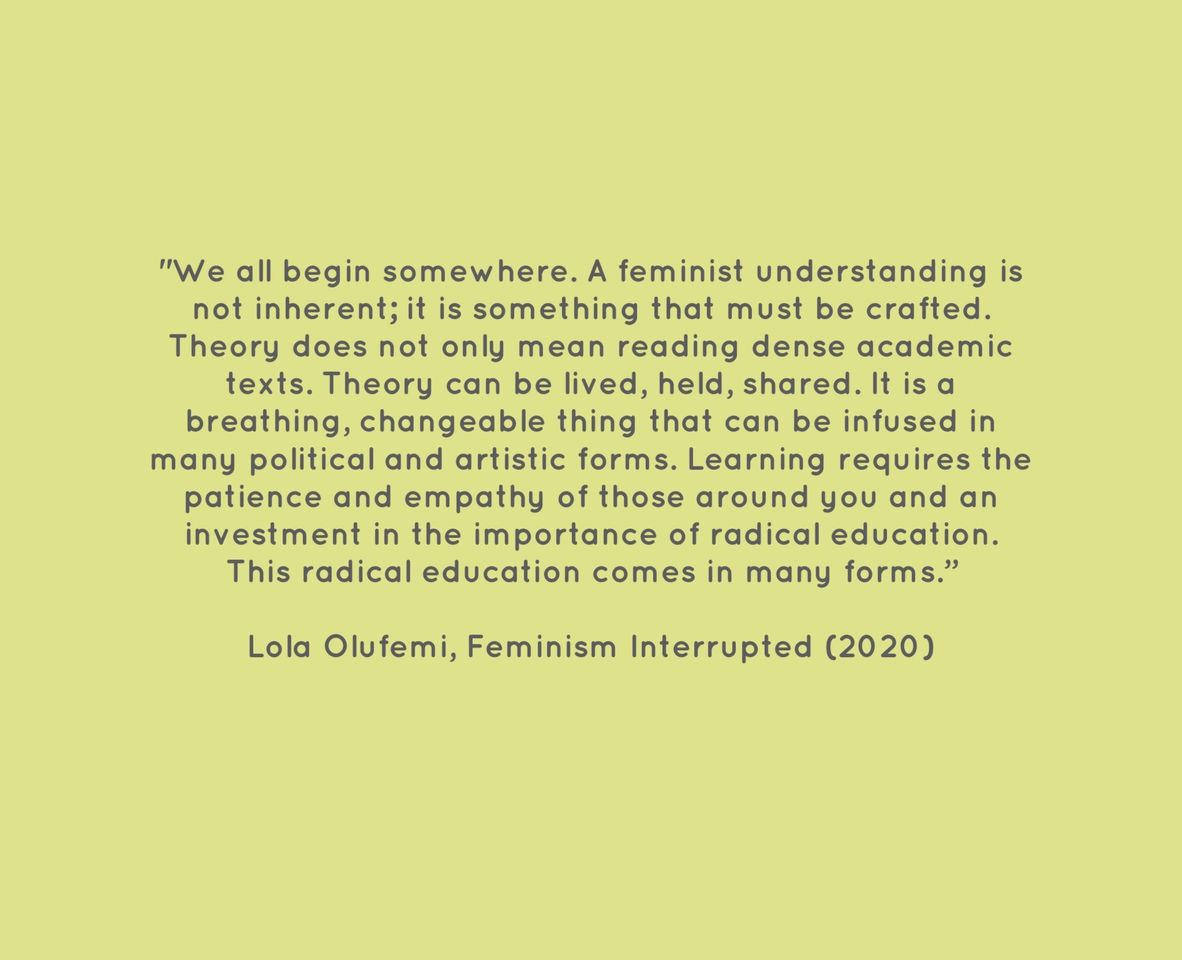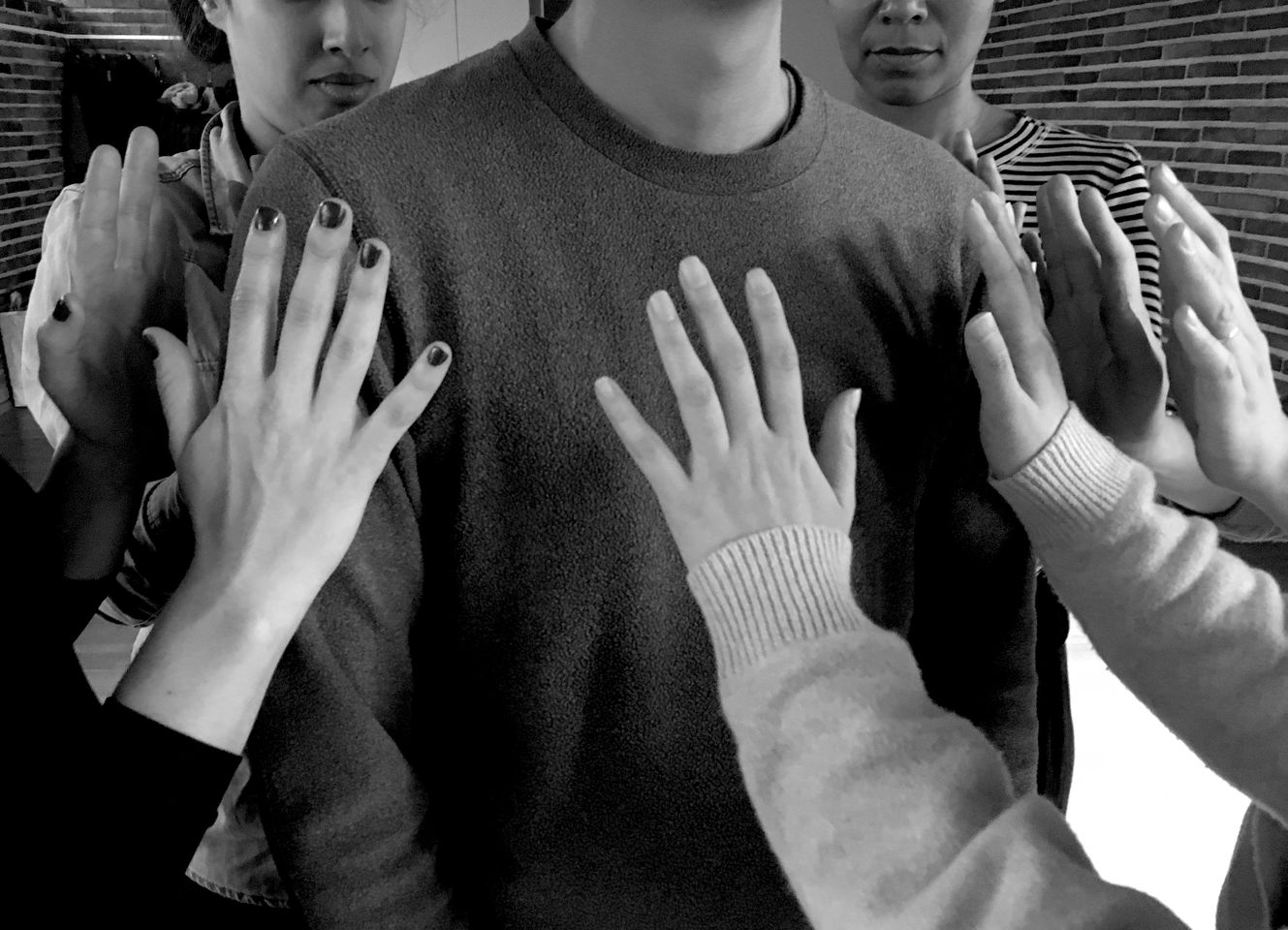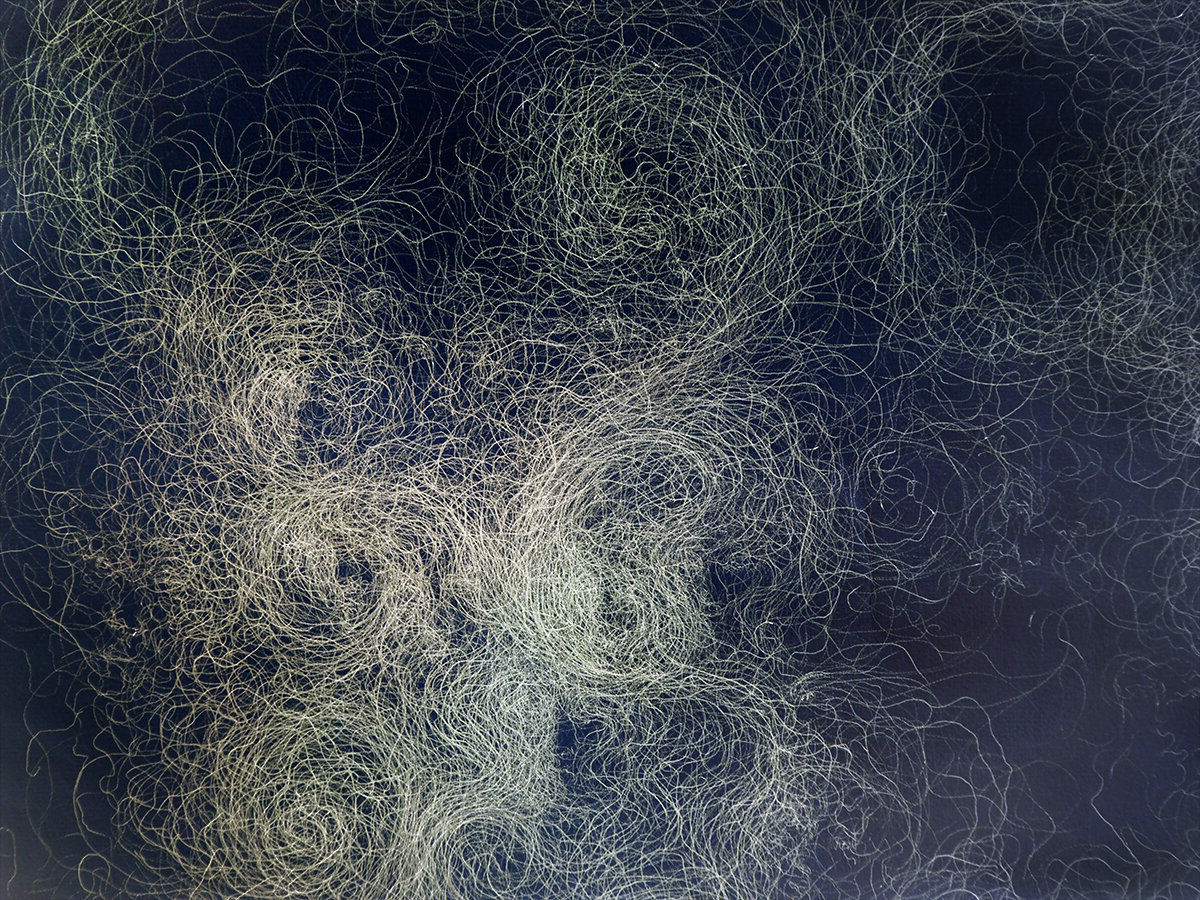International Women's Day 2021: Feminist Practices and Practitioners from the MA ViCCA Programme
"We all begin somewhere. A feminist understanding is not inherent; it is something that must be crafted." - Lola Olufemi, Feminism Interrupted, 2020, (selected reading from Petronella Grönroos & Yvonne Billimore's Reading Aloud Together, 2020).
This International Women's Day, we are taking the time to reflect upon practitioners - artists, curators, educators, collaborators and writers - from the MA in Visual Cultures, Curating and Contemporary Art at Aalto University whose work engages with feminist thinking, methodologies and/or practices. Bringing together current students and alumni, the contributors consider the concepts of nostalgia, care, hope, feminist epistemology, body politics, selenology, decolonization, intersectional justice, agency, trust, hydrofeminism, the environment, and humanity as a network, through a variety of mediums.
From an Instagram account reflecting on a story through time, a collaborative pedagogical zine, and readings of fragments of texts across communication technologies, to the tactile practices of spinning yarns and knotting together invisible stories, moving together to build a network of trust, and flowing with the lines of automatic drawings, the selected bodies of research expose and expand alternative narratives which exist amongst and beyond today's prevailing patriarchal society.
Many thanks to the following contributors for sharing their practices and research for this article on International Women's Day: Athanasía Aarniosuo, Emma Clear, Ji Youn Lee & Marjolein van der Loo, María Paloma Velázquez, María Villa Largacha, Mira Caselius, Petronella Grönroos & Yvonne Billimore, Zahrah Ehsan.

Athanasía Aarniosuo
ViCCA 2019-current
Athanasía is a printmaking artist, art journalist and curator currently based in Vantaa, Finland. In her current work, she focuses on exploring the concepts of 'longing', 'utopia' and especially 'nostalgia.'
The Nostalgia EP
Have you ever been told that you are too emotional, too dramatic, too sensitive? I think you are perfect. I want you to feel safe. Cry if you need to. Tell me anything, I will not judge. Be sentimental. Be radical, just like that. Tell me what you miss, where you’d like to be right now, whom you loved back in 2007. Don’t be scared. Times are changing, it’s our turn now. I’ll go first. See, it’s okay.
"In the Instagram project The Nostalgia EP, I share stories of my life history, as I remember them. I believe the things I miss are integral to my identity. I am overly dramatic and much too sensitive. I sometimes try to hide this part of my personality, but I believe it shouldn’t have to be this way – for me or for anyone. There is nothing embarrassing in emotions and subjective stories, and we should change the patriarchal way of separating them from the public sphere and create safe spaces for everyone to show their weakness."
instagram.com/thenostalgiaep
aarniosuo.com
instagram.com/aarniosuo
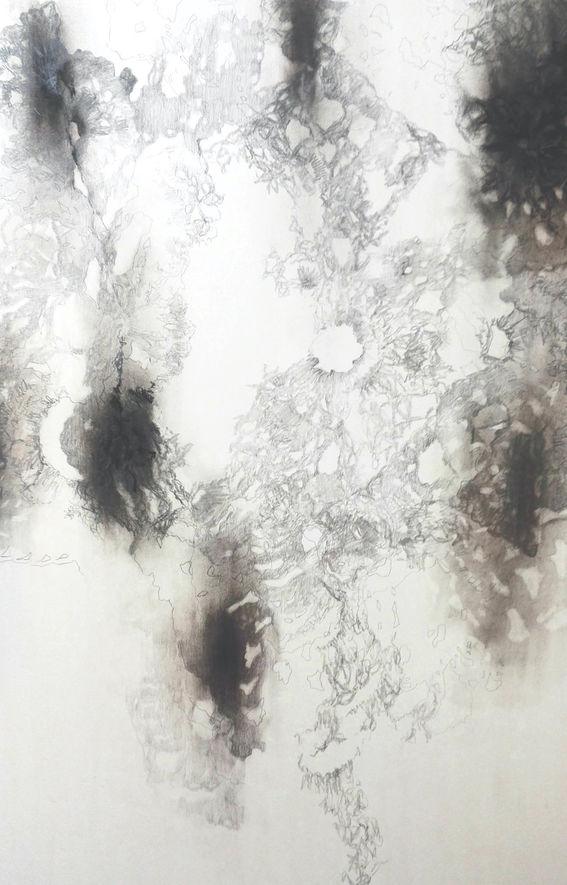
Emma Clear
ViCCA 2018- current
Emma's work explores storytelling through material and concepts of writing, drawing, textile and yarn. She has a background in drawing and installation, and is formerly a founding member of a cooperatively led art gallery.
Spinning Yarns: The Shadow of the Good Shepherd
"This project weaves historical research from my home town of Limerick and its ties to religious institutions, the lace craft movement and an ignored, vulnerable people hidden from view in one of Ireland’s Mother and Baby Homes. A building which was to later house the Limerick School of Art and Design. Through speculative fiction writing, mapping and drawing I follow the threads of these entanglements. I pattern with them as I write and draw and knit these stories together.
To ‘Spin a Yarn’ means to tell a story - I spin yarns with my work. When I tell stories I think through the lineage and patterns that tangle craft stories together. Lines come together to create drawings and text. Yarns knot and tie complex narratives together through crochet, lace and knit. The patterns created, reveal holes and gaps in these long invisible stories.
Silent stories of the ‘feisty’, the ‘fair’ and the ‘fallen’ emerge in my research into the development of the craft industry of Limerick. Land and body politics weave with feminist epistemology and map the complex interconnectivity within. The complex tangle of knotting family stories, textile crafts, and stories of reproductive rights throughout the development of a deeply religious republic state."
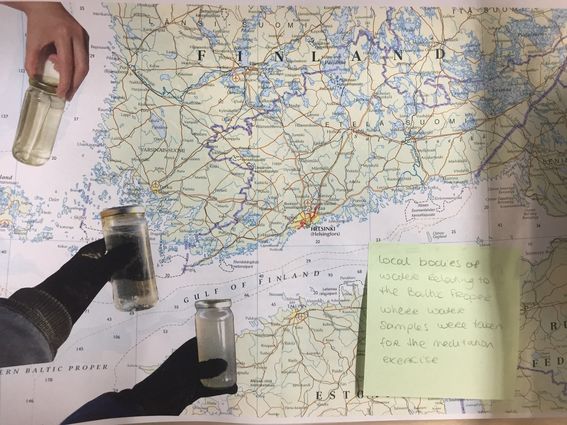
Ji Youn Lee & Marjolein van der Loo
NoVA (Nordic Visual Studies and Art Education) 2018-2020 & ViCCA 2018-current
Ji Youn has been working as an artist and educator based in South Korea. Marjolein is a curator from the Netherlands.
Seeing (in) Waves
“Within the Art, Environment and Education course at Aalto, we started a collaboration. This collaboration is founded on a shared interest in the environment, science, feminism, and pedagogy. We have researched local environmental issues relating to water, critical pedagogy, and hydrofeminist theory. The outcome of this collaboration is becoming a zine: a small-scale publication that combines scientific research with art and experimental exercises in a collection of texts, collages, and workshops.
Seeing (in) Waves is inspired by the bodies of water connected to Otaniemi and Arabia, Helsinki, but will increase the ecological awareness of Aalto students in any surrounding. This small and fun booklet will be inspiring and activating and has actual content that improves human and non-human connections, especially in times of social isolation. We started this project just before the Covid pandemic which has complicated physically working together. Since we both recently returned to our home countries we are planning to continue working on this project overseas.”

María Paloma Velázquez (she/her, they/them)
ViCCA 2018-2021
María is an art worker and independent researcher, currently doing an internship at the Trade Union for Art and Culture Professionals TAKU.
María's most recent personal work explores the complex relationship of feminine and lunar domains. Her research approaches selenology (the scientific study of the Moon) from a transdisciplinary perspective, informed by queer-feminist theory, folklore, deep ecology, photo-based crafts, and astronomy. Her methodology employs writing as a ritual - guided by the Moon's celestial forces and inspired by its mystical legacy - to contemplate the cultural impact and representation of our planetary companion. The work is centered around unacknowledged epistemologies and feminine practitioners in an inquiry into how artistic research can support the decolonization of academic knowledge and empower intersectional justice.

María Villa Largacha
ViCCA 2017-2020
María is a facilitator, editor and researcher. Her work focuses on embodied, collaborative and experimental feminist practices and epistemologies. She is currently UWAS teacher and coordinator at Aalto University.
The Shape of Open. A Journal on Embodied Collective Experience
This MA thesis presents a peer learning process developed through embodied experience in a cross-disciplinary workshop. The three-month workshop, entitled Situated Knowledges and Embodied Practice - SKEP, was offered to students and art practitioners in the fall 2019, to approach the body and personal experience as elements for critical praxis, while proposing safe modes of building trust and awareness. Performative techniques were used to unpack posthuman and feminist views on the body, agency, identity and knowledge, and to reimagine them. The methods included free movement, mapping, experimental writing, and feminist views that articulate theory and practice. Their overlap is intended as a contact zone capable of unsettling the borders between the visual, narrative and intellectual, but also between forms of presence, interdependence, and care across differences.
The thesis is written as an experimental visual journal, using several voices and layers of meaning, threading together insights from exercises as well as theoretical work. The thesis lays out a sequence of incremental interpellation of ideas, bodies and personal boundaries. A deep understanding of process -pedagogical, artistic, personal and interpersonal - is at the core of the research.
The SKEP collective practice has continued developing independently since 2019, and operates currently as collaborative platform.

Mira Caselius
ViCCA 2018-current
Mira is an artist, illustrator and graphic designer. She studied at Art School MAA (2010) and completed her bachelors at Aalto University (2017).
Negative Influence, Night Train
Selected Drawings, 2019-2021
"Most of my art deals with humanity as a network, interconnected beyond space and time, for better and worse. My techniques range from painting with different mediums to pencil and eraser on newspaper. I started to draw with a ballpoint pen on post-it notes while working at a quiet museum five years ago, which in a way set the direction for what I’ve done in the last few years. I drew with what I had at hand, to kill time; mostly faces. I let the capricious trace of my tool lead me as I drew hair and contours. It generated rhythm, currents, motion, surfaces on which new faces would stick. Endless streams of presence where everyone is everything and nothing; the center of their own universe and meaningless to so many. Why do some seem to matter and others do not? There’s no serenity in a void. The darkness is in all of us; those who suffer are surrogate victims."
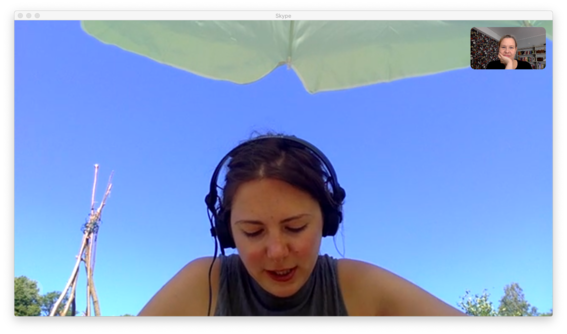
Petronella Grönroos & Yvonne Billimore
ViCCA 2018-current
Petronella has worked for over a decade as an exhibition coordinator and has been involved in coordinating and curating exhibitions, festivals and other events. Yvonne is an artist-curator currently working as associate programme curator at Frame Contemporary Art Finland.
Reading Aloud Together
August 2020
In Reading Aloud Together Petronella Grönroos and Yvonne Billimore draw on their experience of working collaboratively and share some of the approaches they use to support and inform their practices: together and apart. Drawing on fragments from texts and using voice messages, they reflect on and respond to notions of 'care' and 'hope'. The hope is that this collection of readings and responses will provide thoughtful listening experiences.
Texts include: Sara Ahmed, Living a Feminist Life (2017); Lola Olufemi, Feminism Interrupted (2020); Rebecca Solnit, Hope in the Dark (2004).
fcrp.cargo.site/Reading-aloud-together-by-Petronella-Gronroos-Yvonne-Billimore
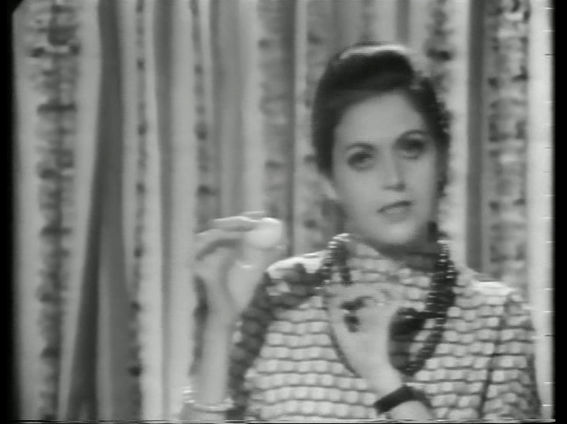
Zahrah Ehsan
ViCCA 2018-2020
Zahrah is a visual artist from Lahore, Pakistan. Ehsan’s practice is deeply experimental: it includes scavenged materials from industry and popular culture which are incorporated into paintings, on-site installations and video art.
Situating Women Feminist Artists in a Global Art Map: Reflections on the Herstories of Pakistani and Western Women Artists
"My thesis research is a work of reflection - analysing, acknowledging and embracing feminist works, movements and writings - that have been informing my art practice. The text consists of two parts, the first part connects my first performative artwork made on gendered social roles, Perfect, isn’t it? (2012) to the well-known works, Handa Hubalna (how to boil an egg) (1972) and Semiotics of the Kitchen (1975) performed by notable feminist artists, Salima Hashmi and Martha Rosler. The second part of the text develops strong links between artist Mierle Laderman Ukeles’ practice of Maintenance Art, and my trajectory and observations as an artist from Pakistan studying and attempting to find suitable jobs in Finland (2018 onwards)."
Perfect, isn’t it? (2012), Zahrah Ehsan
Handa Hubalna (how to boil an egg) (1972), Salima Hashmi
Semiotics of the Kitchen (1975), Martha Rosler
- Published:
- Updated:
